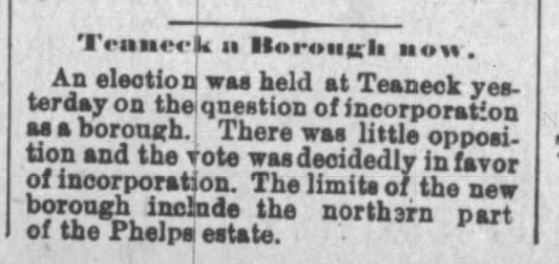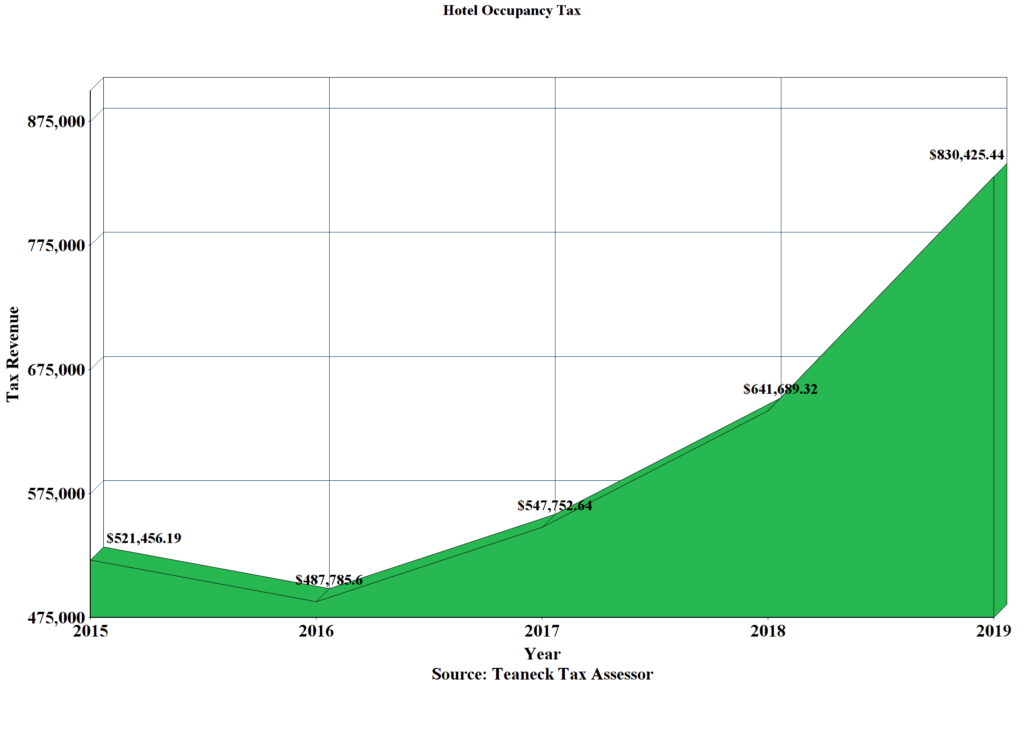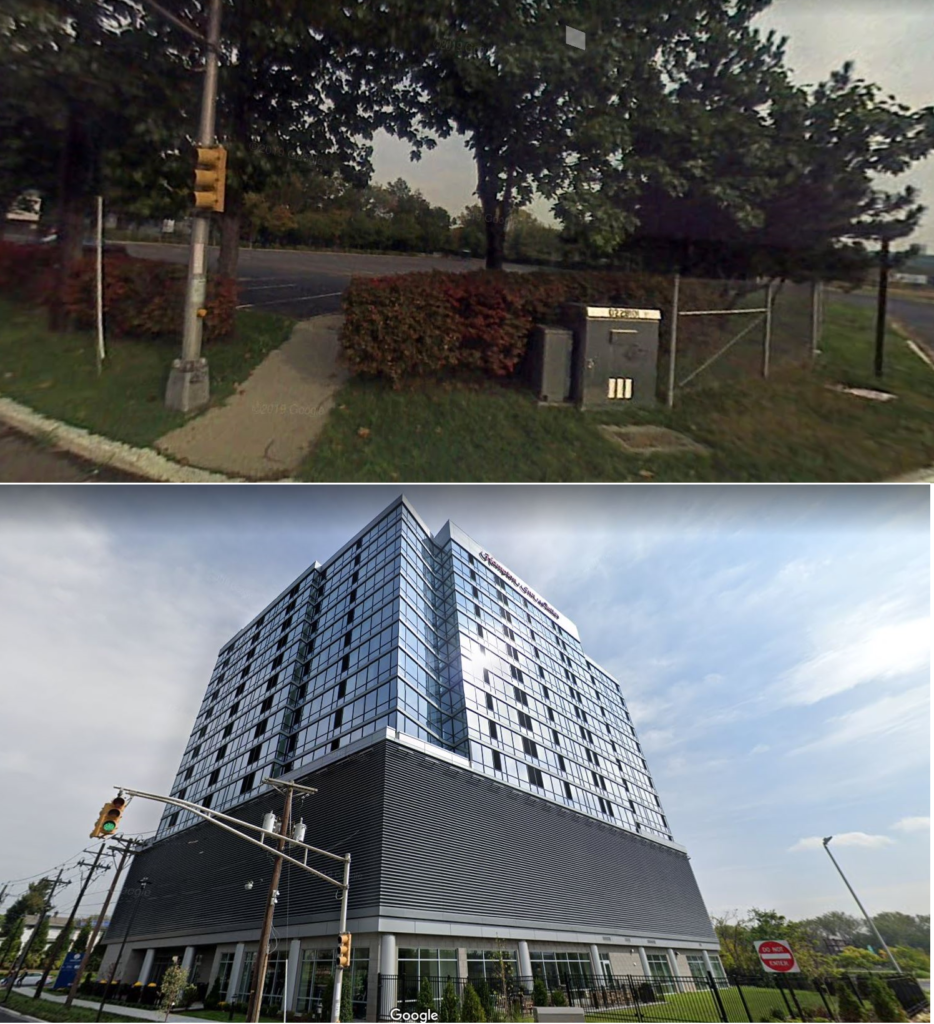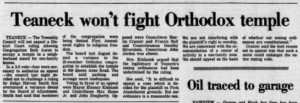It’s an honor to represent everyone in Teaneck – and from our family to yours, I wish you a Happy New Year full of health, happiness and growth.
In January of 1895, residents around these parts voted to create a new entity, to be known as the Township of Teaneck.
March 16, 2020, will mark the 125th Anniversary of the first meeting of Teaneck’s Township Committee in the Sunday School chapel on Washington Avenue (later renamed Teaneck Road). Minutes of the meeting show that street lighting was the first order of business; new electric lamps started to replace the gas & naphtha lamps on Cedar Lane, starting in 1896.
On February 13, 1895, the residents of Teaneck (pop. 811) desiring their own political identity, voted to break from Englewood and Ridgefield Townships creating a new municipality.
March 16, 2020, will mark the 125th Anniversary of the first meeting of Teaneck’s Township Committee in the Sunday School chapel on Washington Avenue (later renamed Teaneck Road). Minutes of the meeting show that street lighting was the first order of business; new electric lamps started to replace the gas & naphtha lamps on Cedar Lane, starting in 1896.
Our history, however, must begin with the Lenape Indians, the native inhabitants of our land who language likely originated the township’s name – “Teaneck,” meaning “place where the trees are”. The contributions of William Walter Phelps, who moved here in 1865, likewise deserve note. Phelps’ estate owned 2,000+ acres of land in the heart of what would become Teaneck (his home sat on the present-day Municipal Green), profoundly influencing our borders, as the Town grew around his holdings. Originally a community of farms and summer vacation homes for the affluent, land sales by the Phelps estate enabled the swift development of new homes for a growing population.
125 years ago, law and order were maintained by two constables. The arrival of automobiles brought complaints from longtime residents. Safety regulations were adopted and by 1914, the township created a full-time police force, adding officers as we grew. Today, the TPD is a professional organization, handling thousands of calls every year on behalf of residents.
By 1915, the volunteer fire associations were brought together and organized into the Municipal Fire Company. As homes increased, so did firefighting needs. Paid firefighters started to complement volunteers in 1920, eventually increasing in number, until a completely professional force was established. Today, the TFD remains one of several professional fire organizations within the county meeting the daily needs of 40,000+ residents and businesses.
Telephone service arrived in 1913 and the Department of Public Works was established in 1917. Our library was opened in 1923 to little fanfare. Holy Name hospital opened in 1925 on Phelp’s land and ruins from a fire at the Phelps home were razed to make room for the Municipal Grounds. After the death of Phelps’ wife in 1929, his estate started to open their land for sale to developers in earnest.
Additional residents created the need for schools. Longfellow School was erected in 1910, followed by Emerson (1916), Whittier (1923), Hawthorne (1925), Bryant (1927), Teaneck High School (1929) and Lowell (1935). When Teaneck High School opened, it had 650 pupils. Dr. Charles Little, the principal of Teaneck High School, purchased 16 acres of land, and opened Bergen Junior College in 1931 (later to become Fairleigh Dickinson University) along River Road.
Detailed plans for sewers, roads, electricity, water and more were the subject of meetings before local committees and planning sessions. Debt mounted.
Teaneck’s population rose 300% between 1920 and 1930 (from 4,192 to 16,513 residents). 471 houses were built in 1926 alone. Residents demanded more crosswalks, more street signs, more trains, garbage collection, a footpath, a trolley bridge and additional streetlights.
But as all times of transition bring with them challenges, the addition of the Depression brought a heavy burden. We edged ever closer to financial ruin.
Bankruptcies increased; the Town found itself largely in debt. Areas of current West Englewood were nicknamed “mortgage heights”. Some bankrupted land was used for public projects, such as our Central Park (later renamed Votee Park). WPA projects, such as the armory and schools, can still be seen.
The opening of the GWB and Route 4 (at a time when additional Phelps property was being sold for development) meant another large growth spurt was on the horizon.
Between 1930 and 1960, the population would more than double, from 16,500 to its current size.
A Change in Government
In 1930, a referendum passed by the people moved Teaneck to a City-Manager form of government. This would prove to have profound long-term consequences.
Under the new plan, five non-partisan councilmembers, elected for 4 year terms, handled policy and legislation. Electing a mayor from among themselves, the council would choose a manager to handle Teaneck’s staff and day-to-day operations.
Leaders Emerged
The choice of Paul Volcker as the first manager, was fortuitous. Mr. Volcker, a civil engineer with previous management experience in Cape May, made quick work bringing an auditor to help in sorting out debts. It would take years to untangle the complicated finances of a town on the verge of bankruptcy. Volcker used every tool at his disposal, even working as the Town Engineer, at a salary of just $1, to save money for the budgets. He would bypass bonding agents and sell directly to bankers, to save on fees.
Under his leadership, we moved to civil service hiring, eliminating many of the politically motivated problems faced by our neighbors.
Milton Votee was mayor for 12 of these formative years (starting in 1934) and helped guide the Township through many planning decisions. No matter was left to chance. Lengthy discussions on everything from hot dog stands to the number of parks for children, were the subject of lengthy debate before council & statutory boards.
In a relatively short time, the Township became a model for the world.
This isn’t hyperbole! The US Army chose Teaneck from among 10,000 communities, to show residents of occupied Japan and Germany how to rebuild from the brink of collapse, after WWII.
A Community Open to All
While the foregoing may paint a picture of a town in ascension, it should be noted that many obstacles stood to be overcome.
In the post-war era, black residents and other minorities were actively kept out of some areas of the community; realtors wouldn’t even show them around. Nefarious real estate agents created fear through block-busting. The people of Teaneck responded.
Civic groups were quickly organized. A resident at the time might see “House Not For Sale” signs on homes. Unscrupulous agents fomenting the fear behind blockbusting were beaten back.
An advisory board on community relations was formed. It worked to bring community members together and foster open communication. Still functioning, it has handled many tasks since its original call, including in the aftermath of a racially charged shooting in the 1990s.
The First Town to Voluntarily Integrate
As one section of the township school system saw minority enrollment rising in the 1960s, the Board of Education hired Dr. Scribner as superintendent. Together he and the board created a formal busing plan to deal with enrollment disparities within schools.
By 1965, after a contentious vote of 7-2, Teaneck would be known throughout the Country as the first municipality to voluntarily integrate its school system.
Another Era of Growth
The Township reached its highest populations (just over 42k residents), as growth accelerated again in the 1970s.
The Glenpointe complex and plans for other areas became the topic of contentious debates over the need for tax ratables.
In 1987, partly fueled by the development decisions, residents voted by referendum to adopt the Council-Manager form of the Faulkner Act. Under this system, seven councilmembers are chosen every other year in staggered elections.
Teaneck Today
Today, Teaneck is a vibrant and diverse community with over 25 parks, nearly 50 houses of worship and multiple business districts. Technology and innovation have enabled the township to better serve residents. In 1998, Teaneck purchased a website to place information online. Agendas, meeting calendars and minutes to track the business of the township can now be accessed by all. Soon, we will deploy a new generation of software to better serve the residents’ needs. Reports and requests can now be submitted electronically.
In the period of 125 years, we moved from 1,000 foot frontages of farms / mills and scattered vacation homes for the elite, to a municipality serving the needs of a diverse citizenry.
With meticulous planning and experts to guide us, we managed near financial collapse, grew departments, schools and services.
We rose to challenges together, staying true to the goals of non-partisan government with a fiercely cultivated multiculturalism. We continue to tackle social issues as we find our path to the future.
Over the coming weeks and months, we hope you will join us as the Library and Township provide historical information about the Town and those that have worked so hard to make us stand out amongst our neighbors.
Happy 125th Birthday, Teaneck.







